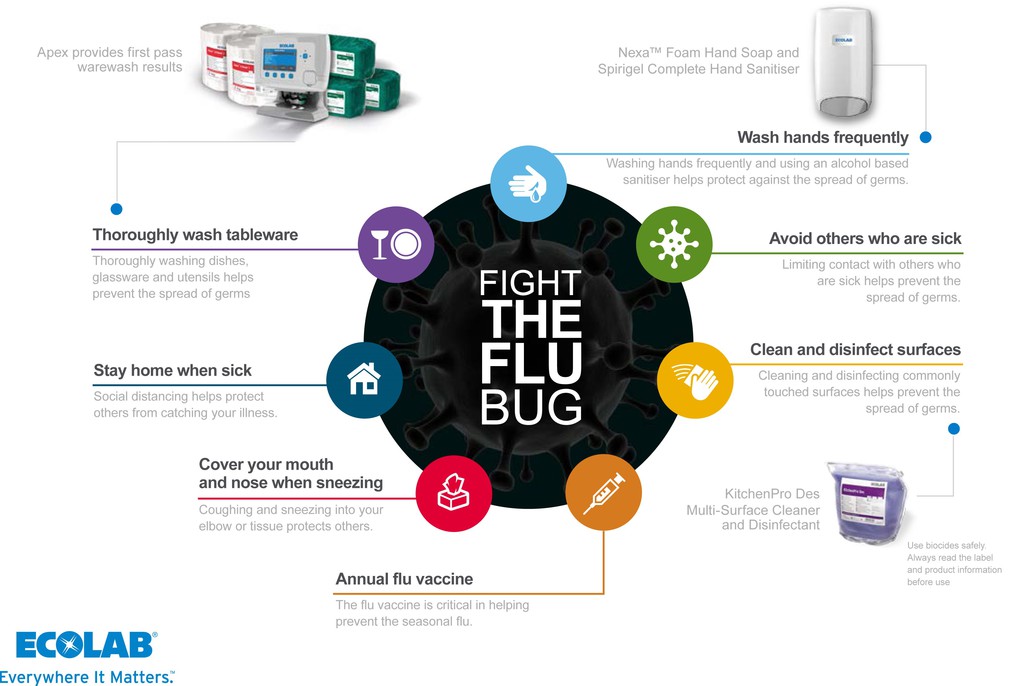

|
Chris Shaw
Editor |
| Home> | FACILITIES MANAGEMENT | >Infection Control & Prevention | >Flu-fighting tips |
Flu-fighting tips
25 November 2016
Seasonal influenza (the flu) is a serious and contagious respiratory infection, generally transmitted through human to human contact. People who have the flu often present with fever, cough, sore throat, runny or stuffy nose, muscle or body aches, headaches and fatigue. The impact on public health and businesses due to seasonal flu can be significant. Fortunately, there are a number of important measures that can help reduce the risk of spreading the seasonal flu.

Dr. John Hanlin, vice president global public health at Ecolab, offers these tips:
Wash your hands frequently
Proper hand hygiene / hand-washing is essential to preventing an influenza contamination. Proper hand-washing helps remove most bacteria, viruses and other pathogens, so they can’t be spread to others. The European Centers for Disease Control and Prevention (ECDC) recommends the following:
- Hands should be washed thoroughly with soap and water
- After washing with soap and water, dry hands thoroughly with single-use paper towels. Hand-washing with drying of hands should last for at least 40-60 seconds each time
- Alcohol-based hand sanitisers reduce the amount of influenza virus on contaminated hands. When hand-washing is not possible, alcohol-based hand sanitisers are an option
Avoid others that are sick & stay home yourself when sick
For the flu to be transmitted the virus must go from an individual who has contracted the flu virus to another person, who can then become infected. Individuals who have contracted the flu virus are contagious at least one day prior to displaying symptoms, and up to seven days after they first appear. You can reduce the risk of this sort of transmission through social distancing by avoiding others who are sick and staying home yourself if sick.
Clean & disinfectant surfaces
The flu virus can survive up to 48 hours on stainless steel and plastic surfaces, and up to 12 hours on cloth, paper and tissues. Proper cleaning and disinfecting can minimise the chances of individuals contracting the virus from a contaminated surface. To properly clean, disinfect and protect your environment:
- Clean any visible soil from surfaces before disinfecting. When cleaning and disinfecting, work from top to bottom and from cleaner to more heavily soiled surfaces.
- Thoroughly wet the surface with a BPD-registered disinfectant with claims for Influenza A and follow label instructions.
- Disinfect frequently touched hard surfaces often, including tables, chairs, light switches, door handles and restroom facilities.
- Give special attention to frequently touched surfaces in food preparation areas, as well as the restroom, including light switches, taps, toilet flush levers, door knobs and handrails.
Get the flu vaccination
Getting a flu vaccine and taking antiviral medications as prescribed if you do contract the flu are two ways the ECDC advocates stopping the spread of flu germs. The flu vaccine is one of the most effective forms of protection against seasonal flu.
Cover your mouth and nose when sneezing
Coughing and sneezing into your elbow or a tissue helps protect others. If you do have seasonal flu and do not cover your nose or mouth a person or persons within two metres can be infected.
Wash your tableware thoroughly
Eating utensils, dishes and glasses should all be thoroughly washed either in a dishwasher or by hand with water and dishwashing detergent.
For additional information visit http://en-uk.ecolab.com/pages/INST-EU-Seasonal-Flu-Page
- Webinar: How to deal with norovirus
- Public health matters: 12 tips from Ecolab experts
- Warewashing system additions
- Handwashing habits 'often not effective'
- Companies combine for hospitality
- Housekeeping programme
- Your 2017 guide to year round pest prevention
- Webinar on seasonal flu prevention
- Norovirus: what's new, what's true and what to do about stomach flu – a free webinar presented by Ecolab
- Food safety tips
- Developed to protect the US military – now fighting UK germs
- The POD – Reduce your paper consumption by up to 20%
- Barcode traceability
- Say goodbye to germs in the workplace
- Weapon in war on superbugs
- Protects knee from infection
- Accessible & educational
- Rent disinfection unit
- Stop cross contamination
- Antimicrobial kneepads





















